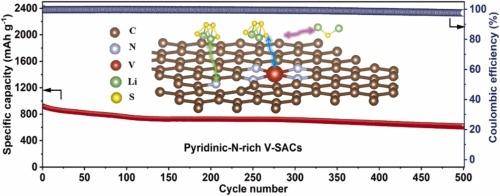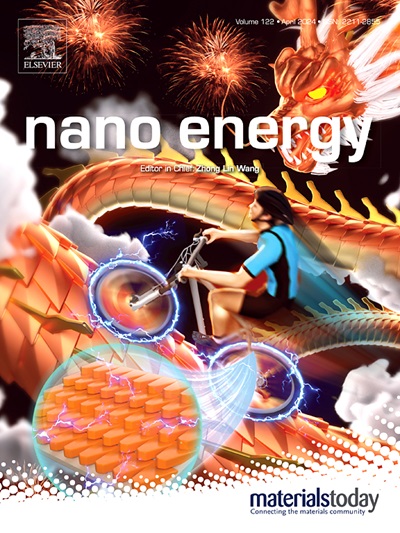Pyridinic-N-rich single-atom vanadium catalysts boost conversion kinetics of polysulfides for high performance lithium-sulfur batteries
IF 16.8
1区 材料科学
Q1 CHEMISTRY, PHYSICAL
引用次数: 0
Abstract
Lithium-sulfur (Li-S) batteries are promising next-generation energy storage devices possessing a high theoretical energy density, but their practical deployment has been hindered by the notorious shuttle effect and sluggish conversion kinetics of soluble lithium polysulfides (LiPSs). In this work, single-atom vanadium catalysts (V-SACs) embedded in pyridinic-N-rich carbon are developed through a simple one-step polymer-assisted pyrolysis approach, which can effectively adsorb LiPSs and remarkably boost the kinetics of LiPSs conversion. The Li-S cells comprising pyridinic-N-rich V-SACs as the sulfur host display an initial discharge capacity of 921.1 mAh g−1 at 1 C and retain a capacity of 605.8 mAh g−1 after 500 cycles, showing a low decay rate of 0.068% per cycle. Even with a high sulfur loading of 6.5 mg cm−2 and a low electrolyte/sulfur ratio of 7.5 μL mg−1, the cell still delivers a high initial areal capacity of 8.1 mAh cm−2 at 0.05 C. Comprehensive experimental studies and density functional theory (DFT) calculations demonstrate that the abundant pyridinic-N sites and vanadium single atoms afford more chemisorption sites for LiPSs and synergistically promote LiPSs conversion kinetics, resulting in enhanced electrochemical performance compared to the Li-S cells without V-SACs.

富含吡啶-N-的单原子钒催化剂提高了多硫化物的转化动力学,可用于高性能锂硫电池
锂硫(Li-S)电池是一种前景广阔的下一代储能设备,具有很高的理论能量密度,但其实际应用却一直受到可溶性多硫化锂(LiPSs)臭名昭著的穿梭效应和缓慢转化动力学的阻碍。本研究通过简单的一步聚合物辅助热解方法,开发出了嵌入富含吡啶-N-的碳中的单原子钒催化剂(V-SACs),它能有效吸附锂多硫化物,并显著提高锂多硫化物的转化动力学。以富含吡啶-N-的 V-SACs 为硫宿主的锂离子电池在 1 C 条件下的初始放电容量为 921.1 mAh g-1,循环 500 次后容量仍保持在 605.8 mAh g-1,衰减率低至每循环 0.068%。即使硫负荷高达 6.5 mg cm-2,电解质/硫比率低至 7.5 μL mg-1,该电池在 0.05 C 时仍能提供 8.1 mAh cm-2 的高初始等离子容量。综合实验研究和密度泛函理论(DFT)计算表明,丰富的吡啶-N位点和钒单原子为锂离子电池提供了更多的化学吸附位点,并协同促进了锂离子电池的转化动力学,从而使电池的电化学性能优于不含V-SAC的锂离子电池。
本文章由计算机程序翻译,如有差异,请以英文原文为准。
求助全文
约1分钟内获得全文
求助全文
来源期刊

Nano Energy
CHEMISTRY, PHYSICAL-NANOSCIENCE & NANOTECHNOLOGY
CiteScore
30.30
自引率
7.40%
发文量
1207
审稿时长
23 days
期刊介绍:
Nano Energy is a multidisciplinary, rapid-publication forum of original peer-reviewed contributions on the science and engineering of nanomaterials and nanodevices used in all forms of energy harvesting, conversion, storage, utilization and policy. Through its mixture of articles, reviews, communications, research news, and information on key developments, Nano Energy provides a comprehensive coverage of this exciting and dynamic field which joins nanoscience and nanotechnology with energy science. The journal is relevant to all those who are interested in nanomaterials solutions to the energy problem.
Nano Energy publishes original experimental and theoretical research on all aspects of energy-related research which utilizes nanomaterials and nanotechnology. Manuscripts of four types are considered: review articles which inform readers of the latest research and advances in energy science; rapid communications which feature exciting research breakthroughs in the field; full-length articles which report comprehensive research developments; and news and opinions which comment on topical issues or express views on the developments in related fields.
 求助内容:
求助内容: 应助结果提醒方式:
应助结果提醒方式:


